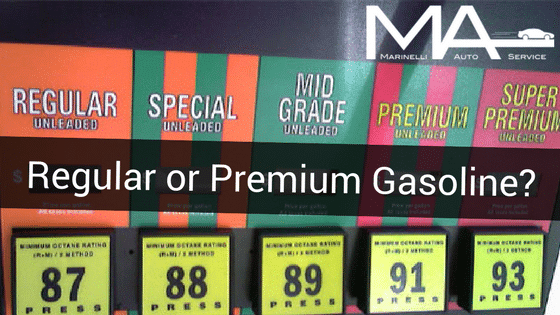A friend recently sent me a photo of the gas options offered at a fueling station and said, “Help! Which one do I use?” There were FIVE options at that particular pump. No wonder she was confused. I have since spent a lot of time researching different gas grades and I finally have an answer for her. What is the right answer for you?
The budget conscious vehicle owner wants to do the right thing to make their car last as long as possible without spending more than they need to. On the other hand, the motor-heads among us may want the highest grade of care no matter the financial output. Whichever category you may fall into, we want to help you make good decisions for your vehicle and your budget when it comes to the gas you use.
Gasoline, Octane, and Power
When you go to the pump, you know there’s going to be at least two or three options of fuel grades to put in your vehicle – Regular, Premium, and one or more grades in-between. For the budget conscious, you may not even think about it and immediately reach for the Regular. Others of you may think, “I want the best!” and proudly reach for the Premium. But have you ever wondered if you should make a different choice – especially when you have as many as FIVE grades of fuel to choose from? What’s the difference and does it matter?
The difference comes down to octane, put simply, the measure of compression of the fuel before it ignites. Of course it’s much more complex than that, but what you need to know is that the numbers you see on the fuel grades (i.e. 87, 89, 93 etc…) represent the level of octane of the fuel. Basically, the higher octane level, the faster the engine will be able to get from 0 to 60mph.
It may seem like the higher the octane, the better for your vehicle, right? Well, maybe…or not necessarily. It really depends on your vehicle’s engine, not how fast you want to go (regardless, you want to drive safely, so flooring your accelerator isn’t the best idea for your vehicle or your safety). High performance vehicles require higher octane levels, while most vehicles you see around town require lower levels. Being as that the lower the octane, the less expensive the gas, that’s good news for most of you!
While your vehicle most likely takes the lowest octane level, please talk to us (or another mechanic you trust) if you are unsure. I would especially encourage you to contact us before you start experimenting with anything beyond your usual selection, especially if you are noticing an issue with your car or truck.
Just beware of judging a pump by it’s label, though. Just because a fuel station offers the level of gasoline you want, doesn’t mean you are putting quality fuel in your tank. A study on Top-Tier gasoline discovered which stations meet the top standards of fuel. These retailers sell Top-Tier gas that provides better driveability and fuel economy.
Not Just Octane
One more important thing to consider when filling up your tank is the matter of when you fill it up. Letting it get to empty and “running on fumes” every time you pull up to the pump can cause issues with your engine. It’s best to fill up before you get to “E”. If I’m driving by a gas station and have time to stop when my tank is half full, I try my best to do so. Otherwise, I usually make sure to fill up at no less than a quarter tank.
Engine issues aside, it’s super inconvenient to run out of gas when you are nowhere near a gas station. This happened to me when Andrew and I were dating. I had to call him in the middle of the night and he came to my rescue. I was so embarrassed. No one likes to do the walk of shame to the pump with a portable gas tank…especially if you’re trying to impress someone special!
Marinelli Auto Service is an auto repair shop in Winter Park, Florida. We’ve been serving Central Florida since 2015. We provide maintenance and repairs for a variety of makes and models.
